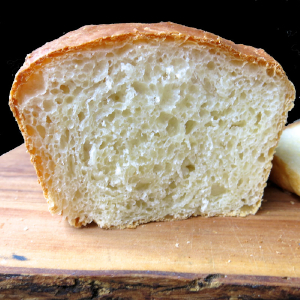We’re on a tour of Canada – the northern neighbour many Americans don’t really know. Yesterday we looked at some all-Canadian mains and sides spanning this vast land. Today, we’ll survey Canadian breads and associated baked goods – an equally broad and varied selection…
 Montreal Style Bagels fresh out of the wood-fired oven. Sesame Seed shown here;
Montreal Style Bagels fresh out of the wood-fired oven. Sesame Seed shown here;
they’re available in a dozen or more different flavours at most bagel bakeries.
For the original, real deal, visit St. Viator or Fairmount Bagels in Montreal.
We’ve talked about the British and French influences that played so large a part in forming the Canadian culture. We’ve also acknowledged the massive waves of immigration from so many other countries that have enriched and embroidered our national cookbook. We can see how those influences have left their mark on everybody’s daily staple.
A 2020 survey posted by Statista.com revealed that bagels were the most popular form of bread in Canada, beating out packaged sliced bread by a hair:
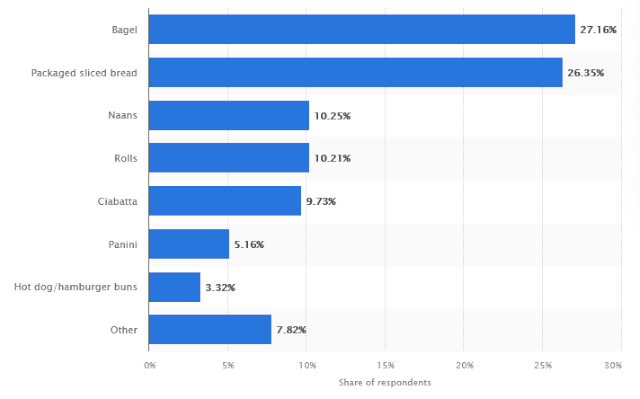 © Statista.com
© Statista.com
This is a great illustration of why folks call Canada a cultural mosaic! Now, let’s look at some of Canada’s own, unique bread products…
On our menu today
Packaged Sliced Bread (PSB): Yes, we’re including it, because it’s the original, baseline Canadian bread – especially in urban centres. Canadian PSB is held to vary from American PSB in that it has a heavier consistency and a coarser crumb. Your sandwiches never fall apart under the weight or moisture of their stuffings! This overriding style description applies equally to Whole Wheat, Cracked Wheat, Multigrain, and the other variants Canadians reach for every time they visit the supermarket.
Bagels: Typically, the unique Montreal Style Bagel if bought at a Bagel bakery, but more often a more bread-like hoop found in most supermarkets. Wikipedia covers the ground most efficiently: “In contrast to the New York-style bagel, which also contains sourdough, the Montreal bagel is smaller, thinner, sweeter and denser, with a larger hole, and is always baked in a wood-fired oven. It contains malt, egg, and no salt, and is boiled in honey-sweetened water before being baked. Genuine Montreal Bagels bagels are still produced by hand and baked in full view of the patrons. There are two predominant varieties: black-seed (poppy seed), or white-seed (sesame seed).” Most often eaten with a schmear of cream cheese and, popularly, smoked salmon, Bagels are eaten with just about anything the diner fancies.
Bannock: An Scottish import flatbread Also known as Frybread; traditionally baked on a hot rock from the fire pit or in a hot skillet. The Canadian Encyclopedia tells us: “Like a hockey puck made of carbohydrates, mostly flour and water, bannock is the stuff of life for many Canadians, particularly [some] Indigenous peoples.
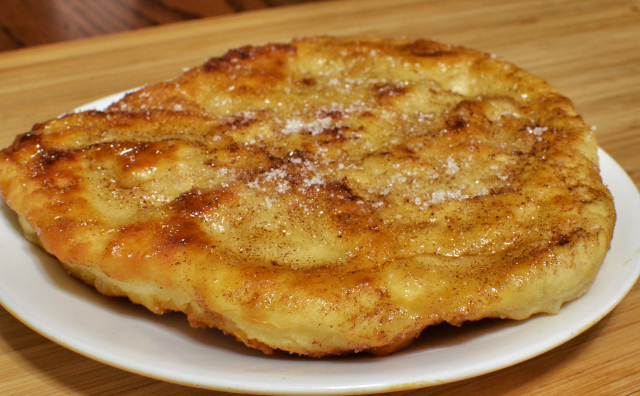
“Most Indigenous nations in North America have some version of bannock. Inuit call it palauga, Mi’kmaq luskinikn, and Ojibwa ba‘wezhiganag. The word derives from the Gaelic bannach, meaning morsel, which in turn likely came from the Latin panis, which means bread. Bannock is usually unleavened, oval-shaped and flat. The version that we know today came from Scotland. In its most rudimentary form it is made of flour, water, and fat or lard. Milk, salt, and sugar are often added, depending on the recipe.”
Newfoundland White Bread: Very different from PSBs! This light, bubbly loaf has some preparation quirks, but not so many as to turn you off making it as your daily bread after you’ve tried it once! (See photo, top of page.) The recipe calls for flour, milk, yeast, butter, salt and sugar. The raising and kneading and so on take a little time, but it’s totally worth it! The same dough recipe is used to make Newfoundland Toutons (see tomorrow’s survey of desserts), perhaps the most iconic and most beloved desert of Canada’s eastern-most province!
Johnny Cake: A modern version of an old recipe. The name is actually a corruption of ‘Journey Cake’, because the original form was developed as a bread that could be packed or carried in a pocket while travelling.
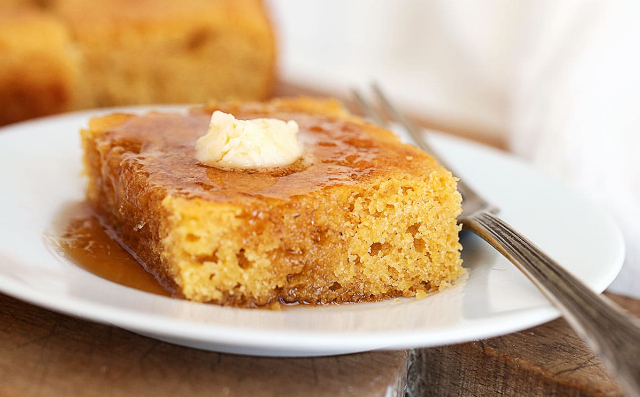
It’s a very different Corn Bread from any other you’ll encounter in the new world, or the old. Ingredients include: Pastry flour (!), corn meal, brown sugar, vegetable shortening, baking powder, milk, eggs, salt and vanilla. This is a Canadian tradition dating back to European antecedents from the middle ages!
Buckwheat Pancakes: A major Canadian ‘fry bread’. You need Buckwheat flour (available from any respectable Canadian supermarket), eggs, molasses, baking soda, salt, milk and oil. You’ve never tasted anything else like them off of a griddle. And you will want to taste them again and again. They fry up just like any other pancake you’ve ever made, but turn down the heat a bit and be prepared to cook them a little longer. Care must be taken not to burn the bottom side (after flipping) before the middle-centre region of the cake cooks through.
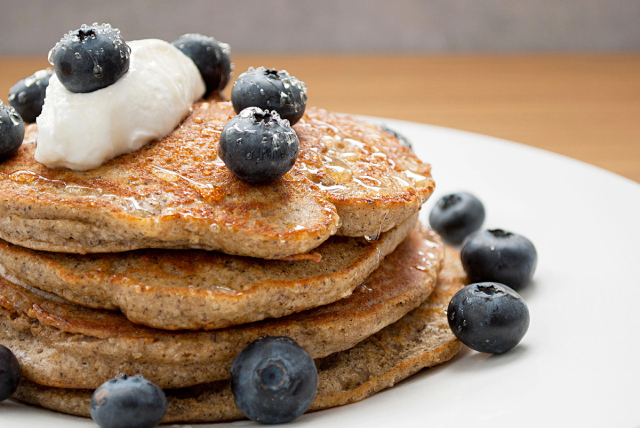
Serve with butter and Maple Syrup – or Golden Syrup to pay homage to Canada’s British heritage and the famous St. Lawrence Corn Starch Company, which has provided Beehive Golden Corn Syrup to all of Canada for 132 years. As late as the 1930s, Canadian kids took their lunch to school in, and froze Beehive Golden Corn Syrup tins filled with water to use as curling stones on their local farm ponds. You can’t hardly get more Canadian than that!
International Breads: All are at home in Canada! Whether it’s Indian Naan or Parathas, English Muffins, Flour or Corn Tortillas, Light or Dark Rye, Challah, Pita, Crèpes, Baguettes, Italian Pizza Crust or Focaccia or Panini or Ciabatta – all are loved by the immigrant cultural groups that brought them here, and by millions of other Canadians who have had the chance to try them as a result. This is your licence to throw caution to the winds when ordering and baking in Canada.
You’ve probably figured it out by now
Canadians enjoy bread and baked goods at every meal, as well as at snack time. Indulge yourself in some Canadian style dining and taste the world!
~ Maggie J.

